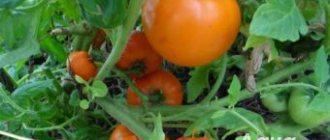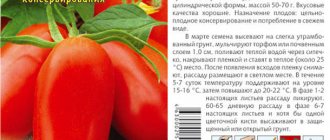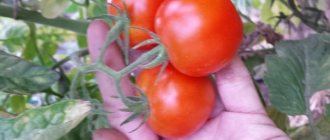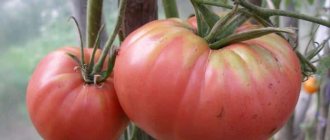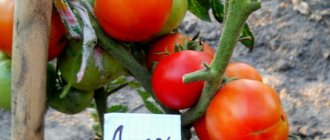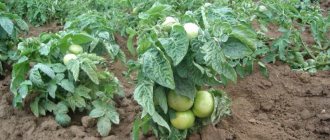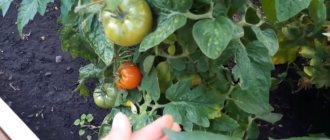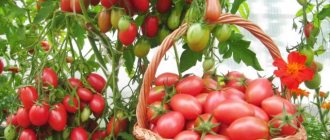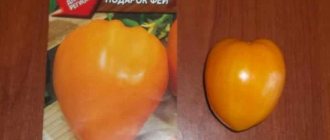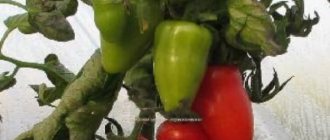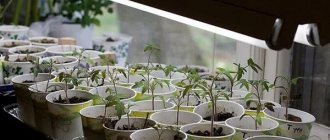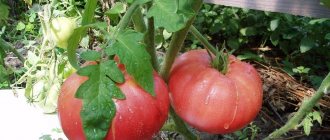Description of the tomato variety Honey Fingers with photo
Honey fingers is a first generation hybrid (F1), bred by Russian breeders. According to some reports, it was included in the register of selection achievements in 2010 (but there is no corresponding entry in the register itself). The culture is heat-loving, so it is recommended to grow it only indoors. However, in the southern regions it can also be cultivated in garden beds.
Main characteristics:
- indeterminate (grows throughout the season);
- tall (180-200 cm);
- mid-season (fruits are formed in 105-115 days).
The bush is standard, without shoots in the lower part, heavily leafy. The leaves are narrow, dark green. Flowering brushes are arranged alternately. On each of them, from 5 to 10 ovaries are formed, which then produce small fruits.
Important! According to reviews from summer residents, Honey Fingers tomatoes are not suitable for growing in northern regions where there is not much light.
Description of fruits
The name Honey Fingers comes from the characteristic yellow color and elongated cylindrical shape of the tomatoes. As the tomatoes ripen, orange stripes appear. The tip is always pointed, the surface is smooth, glossy, without ribbing. The tomatoes are medium-sized, 5-7 cm long, weighing 60-80 g.
The pulp is juicy, also light yellow in color. The mass fraction of dry substances is about 4-6%. The taste is sugary, with honey tones. The cut shows 2-3 nests with seeds. There is no need to collect them, since they will not produce full-fledged offspring: the Honey Fingers tomato is a hybrid, not a variety.
Honey fingers tomatoes have an unusual color and shape
Detailed description of the variety
The Graceful Fingers tomato is a new generation variety.
Specialists of the agricultural company Gavrish brought it out in 2021. Today, the tomato is in the register of the State Variety Commission of the Russian Federation and is approved for cultivation throughout the entire agricultural territory of the country. Recommended for film shelters or stationary greenhouse structures. The bush is tall, covered with medium-sized leaves. The tomatoes are small, dense, with durable thin skin, shaped like an ellipse (see photo). Collected in long thick brushes of 20-25 pieces. The taste of the pulp is sweet, like cherry tomatoes. Tomatoes are especially relished when pickled or pickled. Also suitable for fresh salads, decorating dishes, making juices, tomato dressings, sauces.
Attention! Tomatoes are not classified as cherry tomatoes, despite their small size.
According to ripening time | By type of growth | By type of use | By growing method | Fruit weight (g) | Productivity (kg/m2) | Fetal characteristics |
| Mid-ripe (105-115 days) | Indeterminate (up to 2 m) | Universal | For protected ground | 20-30 | Up to 15 | Red, plum-shaped, smooth, 2 slots |
Characteristics of tomato Honey fingers
Honey fingers are a mid-season hybrid: the fruits are formed in less than 4 months from the moment the seeds are planted. By this time they reach the stage of technical ripeness. It is not necessary to pick the fruits from the bush - they will have time to ripen on the branch. Fruiting is extended over time, lasting from July to the end of August.
Tomato productivity Honey fingers and fruiting
The hybrid is very productive - up to 4-5 kg of fruit can be collected from 1 bush. Some sources give an indicator of 12-14 kg per plant. However, this value is valid in terms of 1 m2.
| Growing method | Greenhouse | In an open garden |
| From 1 bush, kg | 4-5 | 3-4 |
| From 1 m2, kg* | 12-14 | 9-12 |
*It is recommended to plant 3 Honey Fingers tomato bushes per 1 m2, or 4 plants for denser planting.
Maximum yield can be achieved by cultivating tomatoes in a greenhouse, as well as by following certain growing rules:
- Regular but moderate watering.
- Application of complex fertilizing.
- Forming a bush into 2 stems, pinching.
- Tying to a support.
- Preventive treatment for diseases.
To obtain the greatest yield, Honey Fingers tomatoes are recommended to be grown in a greenhouse
Area of application of fruits
Tomatoes are mainly suitable for salads, sandwiches, slicing and preparing various preparations:
- soups;
- vegetable caviar;
- lecho;
- whole-fruit canning (salting, pickling).
The only limitation is that the fruits are not suitable for making tomato juice. They are small in size, so the yield of the final product will be small.
Resistance to diseases and pests
The immunity of this hybrid is quite good - it is resistant to most Solanaceae diseases. However, plants may suffer from phomosis, and the risk of the spread of other diseases cannot be ruled out. Therefore, it is important to follow preventive measures:
- Treat the seedlings with a fungicide a few days before transplanting.
- Ventilate the greenhouse.
- Do not over-wet the soil.
- Destroy insects with insecticides and folk remedies at their first appearance.
- Weed the soil regularly.
- Do not plant tomatoes in the same place for several years in a row.
Rules for planting and care
The Honey Fingers variety is recommended to be grown in seedlings.
To get a decent harvest of tomatoes, you need to correctly carry out all stages of cultivation:
- Preparation and sowing of seedlings.
- Caring for tomato seedlings.
- Planting in a permanent place (greenhouse or vegetable garden).
- Caring for adult plants.
- Harvesting and processing.
Each stage has its own characteristics and nuances.
Sowing seeds for seedlings
Initially, you should calculate the time for sowing seeds for seedlings for a specific region. In addition to the recommendations of the originator of the variety, it is good to use the tips of the lunar calendar
It is important to consider in what soil you plan to grow Honey Fingers. The optimal time is considered to be the first ten days of March.
Important! The age of seedlings when transplanting is 2 months, the weather conditions of the region should be taken into account
- Prepare soil and containers for seedlings. It is best to take a ready-made mixture for seedlings. If you have the opportunity to prepare your own, you will need to mix equal amounts of humus, peat, garden soil, and half the dose of sand. Then add wood ash and mineral fertilizers. Mix the mixture for tomato seedlings thoroughly and pour in a disinfectant composition for disinfection.
- Wash the containers with a solution of potassium permanganate, dry, and fill with soil mixture.
- Soak tomato seeds in a growth stimulator (according to instructions).
Sowing can be done in two ways:
- Make shallow furrows, place tomato seeds, and level the soil.
- Carefully place the seeds on the surface of the soil mixture and cover with a 1 cm thick layer on top.
Moisten the crops with a spray bottle, cover with film until shoots emerge
It is important to maintain the temperature in the range of + 20-26 °C. As soon as shoots appear on the surface, reduce the temperature to + 20 °C during the day and + 12 °C at night
It is important to maintain normal temperatures. Make sure that the plants do not overheat, otherwise the seedlings will stretch. Excessive cooling will lead to diseases and death of seedlings.
During the growth period of seedlings, it is necessary to monitor the level of soil moisture and take measures to ensure that a crust does not form on the surface. It is enough to water tomato seedlings 1-2 times a week. It is best to feed with liquid ready-made complex formulations for vegetable seedlings. Fertilizing must be combined with watering. The photo shows healthy tomato seedlings Honey Fingers:
Transplanting seedlings
When the seedlings form 5-7 true leaves, they are ready for transplanting.
You can grow Honey Fingers in:
- greenhouse;
- open ground;
- film greenhouses.
For midland regions, deadlines must be met. The first ten days of June - open ground, mid-late May - greenhouse, end of April or beginning of May - greenhouse.
The variety must be planted according to a certain pattern. For 1 sq. m you can place no more than 4 plants. After transplantation, the seedlings must be watered and shaded from the sun. It will take 10-14 days for plants to adapt.
Tomato care
The basic rule for a gardener is to create optimal conditions for tomatoes. Honeyfingers need warmth and light. Watering is regulated depending on weather conditions and soil conditions. The best time to water plants is in the evening after sunset.
You can start feeding the plants only after they have taken root. The first time you need nitrogen components. For honey fingers, it is good to use ammonium nitrate or herbal infusion. The next feeding is needed at the time of flowering, then during the formation of ovaries. Complex mineral fertilizers with phosphorus and potassium components are added to these phases.
It is recommended to form a bush with 1 or 2 stems. In this case, it is necessary to remove the side stepchildren, this will have to be done regularly
It is important not to allow the stepson to grow over 10 cm. Tying up the bushes is also a necessary measure
It protects the stems from breakage during the period of abundant fruiting.
To prevent the spread of diseases, preventive treatments with fungicides are necessary. With regular prevention, spraying with biological products is sufficient for Honey Fingers.
If signs of phomosis appear on the plants, immediately treat them with Hom, reduce the amount of nitrogen fertilizers and reduce the frequency of watering. Against dry spotting you can use “Consento”, “Tattu”, “Antrakol”. The main pests of Honey Fingers tomatoes are the rusty mite (“Bison”) and the whitefly (“Confidor”).
Advantages and disadvantages
The Honey Fingers tomato has become popular among summer residents who appreciate the original sweet taste, unusual shape and color. This is a productive hybrid, the cultivation of which requires certain conditions. It is not always possible to purchase such tomatoes in a store, but the efforts will definitely pay off.
Honey finger tomatoes ripening in the garden
pros
- very pleasant, original taste;
- attractive appearance;
- good yield;
- resistance to major diseases;
- can be grown in most regions (in greenhouses);
- good keeping quality and transportability;
- ripening is amicable, fruiting is extended.
Minuses
- you need to purchase seeds every year;
- tomatoes should be pinched and shaped;
- bushes must be tied to a support;
- Honey finger tomatoes are not suitable for making juice or ketchup.
Growing seedlings
They prefer growing Honey Fingers tomatoes in seedlings. This allows the plants to become stronger and develop a viable root system before being transferred to a permanent location, which will allow them to quickly adapt to new conditions. The time for sowing seeds is early or mid-April.
Tatyana Orlova (Vasilidchenko) (candidate of agricultural sciences):
The main importance of the seedling method is the ability to grow heat-loving crops (such as tomatoes) with a long growing season in those regions that have a short growing season (short cold summers). But seedless tomatoes, i.e. grown locally from seed are more adaptable and more viable than seedlings.
The soil for seedlings must be fertile, light, and disinfected. Garden soil, ash, humus, peat, sand or fine sawdust and complex fertilizers are added to it. It is not necessary to disinfect seeds before sowing: producers carry out a complex of their treatment in advance.
Sometimes the growth of planting material is additionally stimulated by soaking it in “Epin”, water with aloe juice, etc.
The seeds are placed in common containers or separate pots to a depth of 1.5-2 cm, carefully sprinkled with soil, and sprayed with warm water from a spray bottle. The boxes are covered with transparent polyethylene and sent to a warm but dark place until the sprouts appear.
Having noticed the first shoots, remove the cover from the container and transfer it to a well-lit place with a stable temperature (18-20 °C). Exceeding the norm of the thermal regime threatens to stretch the seedlings, and their hypothermia can provoke the occurrence of diseases and death of seedlings.
Seedling care
Sowing tomato seeds in common boxes involves picking them into separate pots to further strengthen and grow the root system. This should be done when 2 true leaves appear on the sprout.
The essence of this process is as follows:
- the container with the seedlings is watered beforehand to make it easier to remove the plant from the common container;
- using a sharp knife, carefully pry up the seedling and, together with a lump of earth, transfer it to a separate container with a volume of at least 0.2-0.25 l;
- the plant is placed at the same depth at which it was in the common box, the soil around the stem is slightly compacted and moistened.
Tatyana Orlova (Vasilidchenko) (candidate of agricultural sciences):
When picking, tomato seedlings are buried down to the cotyledon leaves, which makes it possible to increase the size of the root system, because Tomato has the ability to form additional roots on the stem. Pepper and eggplant seedlings, for example, are not buried deep when picking, because these crops do not form roots on the stem.
During the entire period of growth and development of seedlings, it is necessary to water it in a timely and moderate manner. If the seedlings are pale, have an unhealthy appearance, and develop poorly, it is recommended to apply mineral and organic fertilizers in liquid form to the soil under the seedlings. This contributes to their fastest and most uniform distribution over the soil surface.
7-10 days before transplanting seedlings to a permanent place, you need to start hardening them: the plants are taken out into fresh air every day or the temperature in the room where they are is lowered. Every day the duration of this procedure increases.
Features of cultivation
Seeds for seedlings are sown in mid-March with the expectation that transplantation into the ground will occur in 2 months. Containers or wooden boxes can be used as planting containers. Pre-requisite:
- Prepare the soil - it is advisable to purchase it at the store. Disinfect in a solution of potassium permanganate or hydrogen peroxide.
- Treat the seeds in a fungicide or potassium permanganate (30 minutes), soak in a stimulant solution (Epin, Zircon, Kornevin).
- Place the soil in containers and make several grooves at a distance of 4-5 cm, 1 cm deep.
Initially, seedlings are grown in greenhouse conditions:
- abundant hydration;
- temperature 23-25 degrees;
- illumination with a phytolamp up to 14-15 hours a day;
- containers under a glass lid or film with holes.
After 2-3 leaves appear, they are transplanted into separate glasses with the same soil. Feed with complex fertilizer, reduce the temperature to room temperature. A week before transplanting, harden off and spray with fungicide.
To prevent Honey Fingers tomato seedlings from stretching, it is advisable to reduce the temperature by 2-3 degrees at night
Honey fingers tomato seedlings are transferred to open ground at the end of May, and to the greenhouse in the middle of the month. The bushes are placed at a distance of 50 cm from each other, 60 cm between rows. During the first 2 weeks, it is important to provide shade - for example, using loose fabric or sheets of white paper.
The rest of the care is standard - watering 2-3 times a week, fertilizing once every 2-3 weeks, mulching, weeding, loosening the soil. The bushes are regularly pruned, formed into 1-2 stems and tied to a support.
How to grow tomatoes
To grow a rich and tasty harvest of Strega f1 tomatoes, follow our recommendations.
Landing
It is best to plant seedlings in open ground in cloudy weather or in the evening. The distance between the rows is 50–70 cm, and the sprouts are spaced 30–40 cm apart from each other.
Landing algorithm:
- Make holes 15 cm deep.
- Sprinkle each hole with plenty of water.
- Plant the seedlings, deepening them to the cotyledon leaves.
- Sprinkle the seedlings with soil, compact it so that the sprouts do not fall.
Important! Overgrown seedlings are tied to stakes
Seedling care
Basic procedures for obtaining a rich harvest:
- Watering. There is no need to water the first week after planting the seedlings, because the sprouts need to take root. Then watering is carried out as the soil dries. The optimal water consumption for 1 bush is 2–5 liters. Tomatoes are watered only at the root, and not from above. It is recommended to loosen it every time the soil is moistened.
- Feeding. Fertilizers are applied for the first time 15–20 days after planting the seedlings. To do this, use ready-made complex formulations and prepare the solution in accordance with the instructions. The tomatoes are fed the second time after the first flowering and during the formation of buds. Fertilize the third time during the appearance of the first fruits.
- Pinching and pruning. Stepchildren take nutrients from plants, so they need to be removed. If this is not done, the growth of tomatoes and their fruiting will slow down, and may even stop altogether. Experts advise getting rid of unnecessary shoots exclusively with your fingers, without using pruners and scissors, while leaving stumps 1 cm long. Also, the Strega hybrid gets rid of the lower leaves - this procedure is performed after the first ovaries appear. Trimming the lower leaves is done with pruners or scissors.
- Garter. As soon as the bush grows above 50 cm, it is recommended to tie it up. It is best to use trellises.
Features of cultivation and possible difficulties
In equipped greenhouses, Strega f1 tomato is grown even in winter. The culture is unpretentious to climatic conditions.
In open ground, it is not recommended to plant seedlings in a sunny place, otherwise the leaf blades will be burned. It is better to choose partial shade. Tomatoes should be protected from drafts. You cannot plant seedlings in a wetland. This will cause the stems and leaves to rot.
Diseases and pests
You should be concerned if spots appear on the leaf blades and fruits. The appearance of mold on the leaves is also dangerous. If such diseases occur, the affected parts must be removed and then the plant must be treated with fungicides.
The hybrid is resistant to the following diseases:
- fusarium;
- withering;
- late blight;
- tobacco mosaic virus.
The best remedies for tomato diseases are prevention (disinfection of seeds and soil, loosening, weeding) and proper agricultural technology.
Pest and disease control
The main preventive measure against fungal diseases is treating seedlings with fungicides a few days before transplanting into the ground. To do this, you can use any proven drug:
- "Home";
- "Fitosporin";
- "Ordan";
- "Skor";
- "Fundazol";
- Bordeaux mixture.
Insecticides are used to kill insects and other pests:
- "Fitoverm";
- "Vertimek";
- "Spark";
- "Aktara";
- "Fufanon";
- "Green Soap"
If the invasion is not very large, it is better to spray the bushes with homemade solutions based on baking soda, ammonia, onion peels, chili peppers, mustard powder, and a decoction of potato tops. Treatment is carried out only in the evening, when grown in open ground - in calm and dry weather. If chemicals are used, fruits can only be collected after the waiting period has expired (it is always specified in the instructions).
Advice! The greenhouse must be treated with disinfectants in the fall (or early spring). To speed up the process, you can use a tobacco or sulfur smoke bomb.
